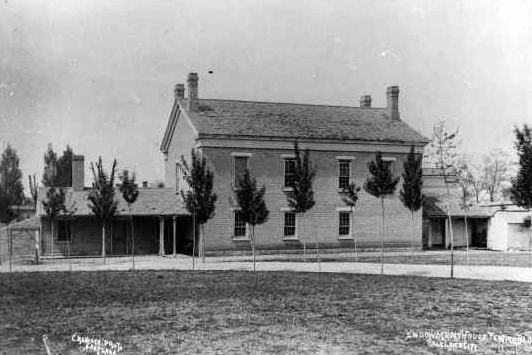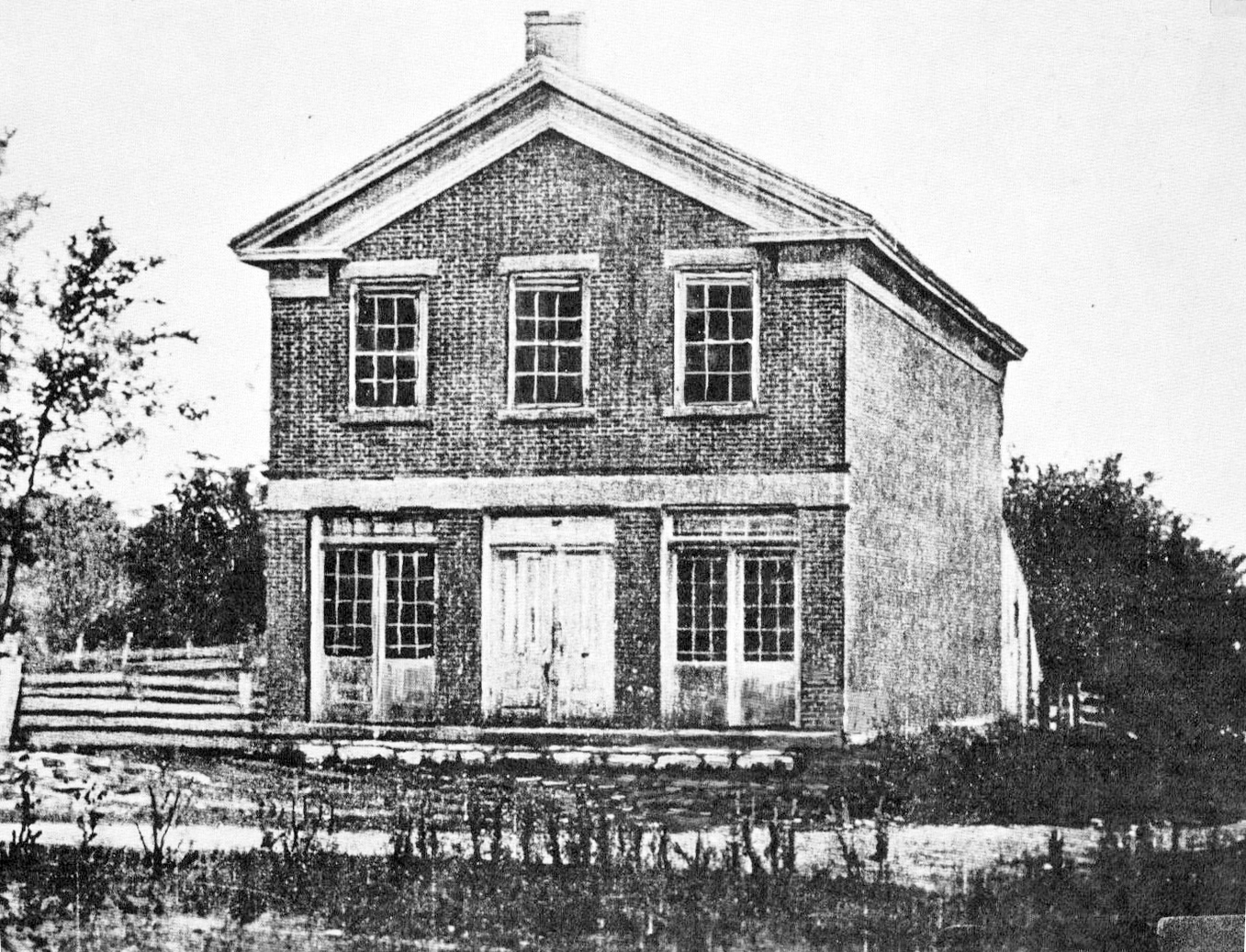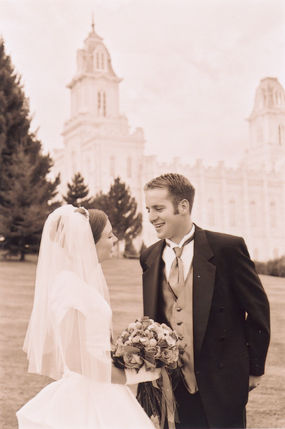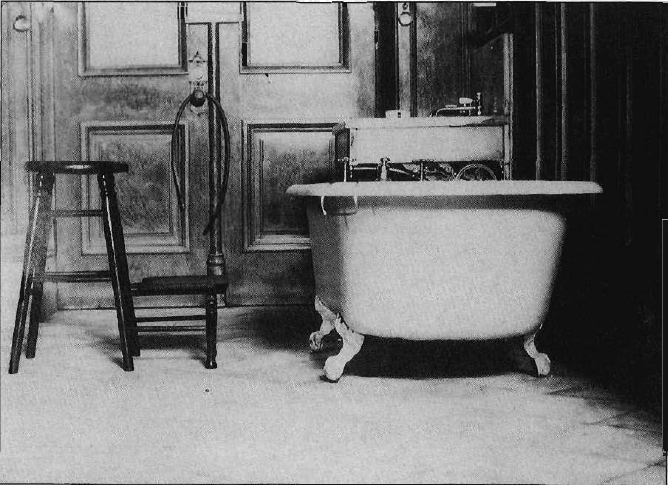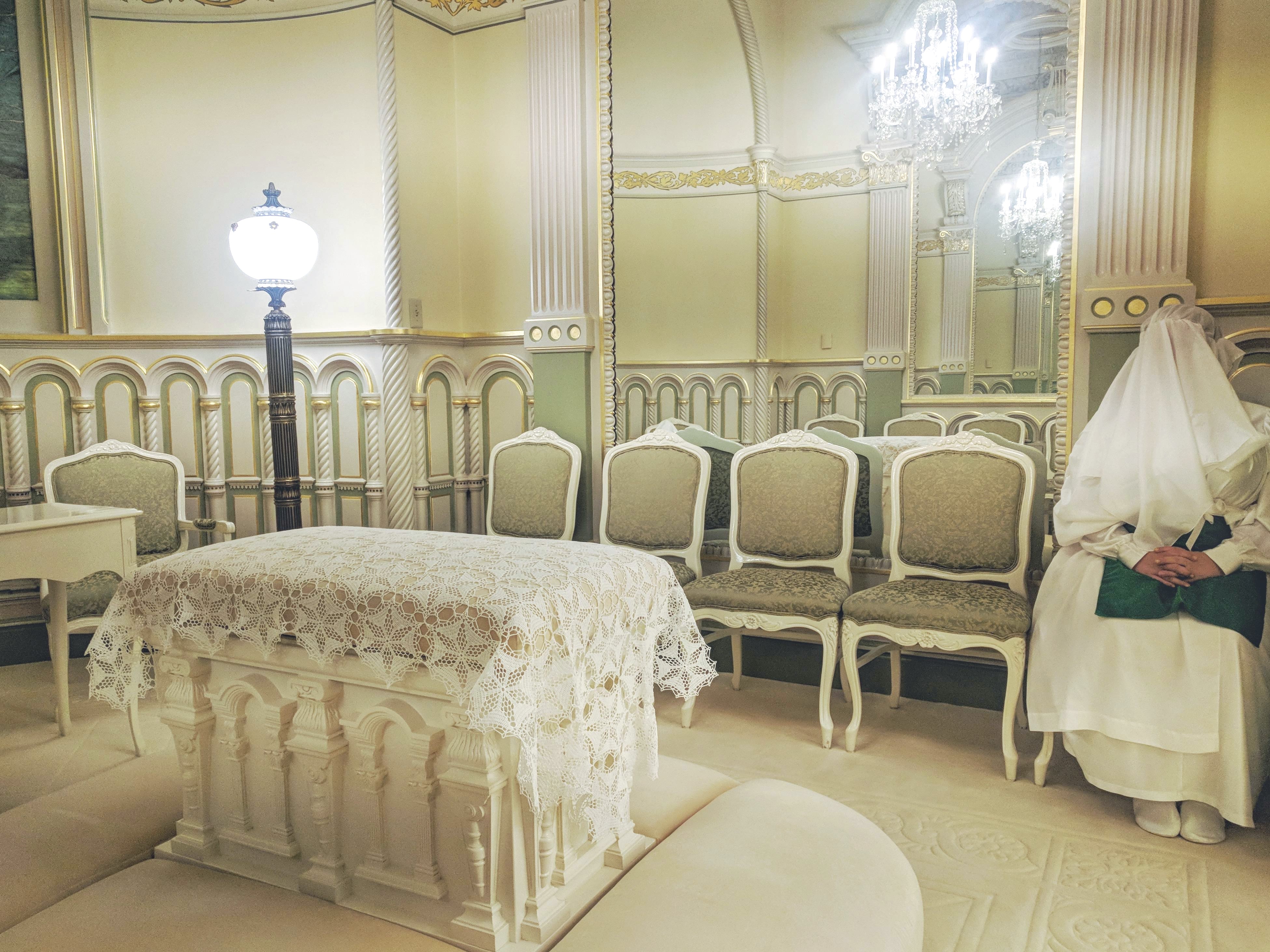|
Endowment House
The Endowment House was an early building used by the Church of Jesus Christ of Latter-day Saints (LDS Church) to administer temple ordinances in Salt Lake City, Utah Territory. From the construction of the Council House in 1852, Salt Lake City's first public building, until the construction of the Endowment House, the members of the LDS Church used the top floor of the Council House for administering temple ordinances. When this arrangement proved impractical, Brigham Young directed Truman O. Angell, architect of the Salt Lake Temple, to design a temporary temple. Completed in 1855, the building was dedicated by Heber C. Kimball and came to be called the Endowment House after the endowment ceremonies that were conducted inside it. Appearance The Endowment House stood on the northwest corner of Temple Square. Initially, it was a two-story adobe building, , with a single-story extension on its north side. In 1856, another extension was added on its south side and a baptistry on ... [...More Info...] [...Related Items...] OR: [Wikipedia] [Google] [Baidu] |
Red Brick Store
The Red Brick Store in Nauvoo, Illinois, was a building that was constructed and owned by Joseph Smith, the founder of the Latter Day Saint movement. Original building Smith constructed the Red Brick Store in 1841. The building became a center of economic, political, religious, and social activity among the Latter Day Saints. In addition to being a mercantile store, the second floor of the building also served as the headquarters of the Church of Jesus Christ of Latter Day Saints for a period of time. Members would visit the store to pay their tithing and other offerings to the church. Notable events A number of important events in Latter Day Saint history occurred in the Red Brick Store, including: *the organization of the Relief Society, the church's organization for women, on March 17, 1842; and *the first performance of the Nauvoo Endowment ordinance, on May 4, 1842. Destruction and rebuilding After Joseph Smith was killed and the majority of Latter Day Saints left Nauv ... [...More Info...] [...Related Items...] OR: [Wikipedia] [Google] [Baidu] |
Sealing (Latter Day Saints)
Sealing is an ordinance (ritual) performed in Latter Day Saint temples by a person holding the sealing authority. The purpose of this ordinance is to seal familial relationships, making possible the existence of family relationships throughout eternity. Sealings are typically performed as marriages or as sealing of children to parents. They were performed prior to the death of Joseph Smith (the founder of the Latter Day Saint movement), and are currently performed in the largest of the faiths that came from the movement, The Church of Jesus Christ of Latter-day Saints (LDS Church). LDS Church teachings place great importance on the specific authority required to perform these sealings. Church doctrine teaches that this authority, called the priesthood, corresponds to that given to Saint Peter in . Sealings Faithful Latter Day Saints believe civil marriages are dissolved at death, but that a couple who has been sealed in a temple will be married beyond physical death and the res ... [...More Info...] [...Related Items...] OR: [Wikipedia] [Google] [Baidu] |
Washing And Anointing
Washing and anointing (also called the initiatory) is a temple ordinance practiced by the Church of Jesus Christ of Latter-day Saints (LDS Church) and Mormon fundamentalists as part of the faith's endowment ceremony. It is a sacred ordinance for teenagers and young adults, similar to chrismation. The ordinance is performed by the authority of the Melchizedek priesthood by an officiator of the same gender as the participant. In the ritual, a person is sprinkled with water, which is symbolically similar to the washing done by priests prior to entering the temple during the time of Moses. After the washing, the officiator anoints the person with consecrated oil while declaring blessings. The officiator then declares that the person is anointed to become a "king and priest" or a "queen and priestess" in the afterlife. Once washed and anointed, the participant is dressed in the temple garment, a religious white undergarment which the participant is instructed to wear throughout his ... [...More Info...] [...Related Items...] OR: [Wikipedia] [Google] [Baidu] |
Baptism For The Dead
Baptism for the dead, vicarious baptism or proxy baptism today commonly refers to the religious practice of baptizing a person on behalf of one who is dead—a living person receiving the rite on behalf of a deceased person. Baptism for the dead is best known as a doctrine of the Latter Day Saint movement, which has practiced it since 1840. It is currently practiced by the Church of Jesus Christ of Latter-day Saints (LDS Church), where it is performed only in dedicated temples, as well as in several other current factions of the movement. Those who practice this rite view baptism as an essential requirement to enter the Kingdom of God, and therefore practice baptism for the dead to offer it by proxy to those who died without the opportunity to receive it. The LDS Church teaches that those who have died may choose to accept or reject the baptisms done on their behalf. Baptism for the dead is mentioned in () as proof of a physical resurrection, though the exact meaning of the phra ... [...More Info...] [...Related Items...] OR: [Wikipedia] [Google] [Baidu] |
Baptismal Font
A baptismal font is an article of church furniture used for baptism. Aspersion and affusion fonts The fonts of many Christian denominations are for baptisms using a non-immersive method, such as aspersion (sprinkling) or affusion (pouring). The simplest of these fonts has a pedestal (about tall) with a holder for a basin of water. The materials vary greatly consisting of carved and sculpted marble, wood, or metal. The shape can vary. Many are eight-sided as a reminder of the new creation and as a connection to the practice of circumcision, which traditionally occurs on the eighth day. Some are three-sided as a reminder of the Holy Trinity: Father, Son, and Holy Spirit. Fonts are often placed at or near the entrance to a church's nave to remind believers of their baptism as they enter the church to pray, since the rite of baptism served as their initiation into the Church. In many churches of the Middle Ages and Renaissance there was a special chapel or even a separate build ... [...More Info...] [...Related Items...] OR: [Wikipedia] [Google] [Baidu] |
Bathroom
A bathroom or washroom is a room, typically in a home or other residential building, that contains either a bathtub or a shower (or both). The inclusion of a wash basin is common. In some parts of the world e.g. India, a toilet is typically included in the bathroom; in others, the toilet is typically given a dedicated room separate from the one allocated for personal hygiene activities. In North American English the word 'bathroom' is sometimes used to refer to any room in a residence that contains a toilet, regardless of the inclusion of a bath or shower. Historically, bathing was often a collective activity, which took place in public baths. In some countries the shared social aspect of cleansing the body is still important, as for example with '' sento'' in Japan and the "Turkish bath" (also known by other names) throughout the Islamic world. Variations and terminology The term for the place used to clean the body varies around the English-speaking world, as does the ... [...More Info...] [...Related Items...] OR: [Wikipedia] [Google] [Baidu] |
Utah
Utah ( , ) is a state in the Mountain West subregion of the Western United States. Utah is a landlocked U.S. state bordered to its east by Colorado, to its northeast by Wyoming, to its north by Idaho, to its south by Arizona, and to its west by Nevada. Utah also touches a corner of New Mexico in the southeast. Of the fifty U.S. states, Utah is the 13th-largest by area; with a population over three million, it is the 30th-most-populous and 11th-least-densely populated. Urban development is mostly concentrated in two areas: the Wasatch Front in the north-central part of the state, which is home to roughly two-thirds of the population and includes the capital city, Salt Lake City; and Washington County in the southwest, with more than 180,000 residents. Most of the western half of Utah lies in the Great Basin. Utah has been inhabited for thousands of years by various indigenous groups such as the ancient Puebloans, Navajo and Ute. The Spanish were the first Europe ... [...More Info...] [...Related Items...] OR: [Wikipedia] [Google] [Baidu] |
Mural
A mural is any piece of graphic artwork that is painted or applied directly to a wall, ceiling or other permanent substrate. Mural techniques include fresco, mosaic, graffiti and marouflage. Word mural in art The word ''mural'' is a Spanish adjective that is used to refer to what is attached to a wall. The term ''mural'' later became a noun. In art, the word mural began to be used at the beginning of the 20th century. In 1906, Dr. Atl issued a manifesto calling for the development of a monumental public art movement in Mexico; he named it in Spanish ''pintura mural'' (English: ''wall painting''). In ancient Roman times, a mural crown was given to the fighter who was first to scale the wall of a besieged town. "Mural" comes from the Latin ''muralis'', meaning "wall painting". History Antique art Murals of sorts date to Upper Paleolithic times such as the cave paintings in the Lubang Jeriji Saléh cave in Borneo (40,000-52,000 BP), Chauvet Cave in Ardèche departmen ... [...More Info...] [...Related Items...] OR: [Wikipedia] [Google] [Baidu] |
Garden Of Eden
In Abrahamic religions, the Garden of Eden ( he, גַּן־עֵדֶן, ) or Garden of God (, and גַן־אֱלֹהִים ''gan-Elohim''), also called the Terrestrial Paradise, is the Bible, biblical paradise described in Book of Genesis, Genesis 2-3 and Book of Ezekiel, Ezekiel 28 and 31. The location of Eden is described in the Book of Genesis as the source of four tributaries. Various suggestions have been made for its location: at the head of the Persian Gulf, in southern Mesopotamia (now Iraq) where the Tigris and Euphrates rivers run into the sea; and in Armenia. Like the Genesis flood narrative, the Genesis creation narrative and the account of the Tower of Babel, the story of Eden echoes the Ancient Mesopotamian religion, Mesopotamian myth of a king, as a primordial man, who is placed in a divine garden to guard the tree of life. The Hebrew Bible depicts Adam and Eve as walking around the Garden of Eden naked due to their sinlessness. Mentions of Eden are also made in ... [...More Info...] [...Related Items...] OR: [Wikipedia] [Google] [Baidu] |
William Ward (Utah Architect)
William Ward (September 2, 1827 in Leicester, England – January 13, 1893 in Utah) was an architect, artist, and builder. Born in England, he converted to Mormonism Mormonism is the religious tradition and theology of the Latter Day Saint movement of Restorationist Christianity started by Joseph Smith in Western New York in the 1820s and 1830s. As a label, Mormonism has been applied to various aspects of t ... and emigrated to Utah in 1850. While there, he carved Utah's block of limestone for the Washington Monument. In 1856, he moved to St. Louis, Missouri, and continued to live in the Midwest until returning to Utah in 1888. He died of lung fever in 1893, shortly after his wife succumbed to pneumonia. A couple of his works are listed on the U.S. National Register of Historic Places. Works Gallery File:Francis Armstrong House 667 E. 100 South Salt Lake City Utah 84102 USA.jpg, Francis Armstrong House, 667 E. 1st South Salt Lake City, UT*National Register of Historic ... [...More Info...] [...Related Items...] OR: [Wikipedia] [Google] [Baidu] |
Sealing (Mormonism)
Sealing is an ordinance (ritual) performed in Latter Day Saint temples by a person holding the sealing authority. The purpose of this ordinance is to seal familial relationships, making possible the existence of family relationships throughout eternity. Sealings are typically performed as marriages or as sealing of children to parents. They were performed prior to the death of Joseph Smith (the founder of the Latter Day Saint movement), and are currently performed in the largest of the faiths that came from the movement, The Church of Jesus Christ of Latter-day Saints (LDS Church). LDS Church teachings place great importance on the specific authority required to perform these sealings. Church doctrine teaches that this authority, called the priesthood, corresponds to that given to Saint Peter in . Sealings Faithful Latter Day Saints believe civil marriages are dissolved at death, but that a couple who has been sealed in a temple will be married beyond physical death and the res ... [...More Info...] [...Related Items...] OR: [Wikipedia] [Google] [Baidu] |
